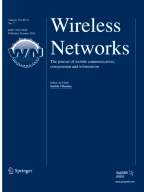Abstract
Underwater Media Access Control (MAC) protocol design faces more challenges due to the unique characteristics of acoustic communication such as the long propagation delay and limited bandwidth. The long propagation delay in underwater causes the hidden terminal and spatially unfair problem. In this paper, we propose an efficient MAC protocol for multi-hop underwater acoustic sensor networks, which we shall call the EHM—Efficient Handshaking Mechanism. It is a handshaking-based protocol that addresses the hidden terminal and spatially unfair problem, and the EHM protocol can improve the channel utilization by allowing a node to receive data packets from multiple potential senders simultaneously. This method can reduce the relative proportion of time spent on control packets. The performance of the proposed protocol is evaluated via simulations. Experiment results show that the EHM protocol outperforms in channel utilization, fairness of transmission and end-to-end packets delay.
Similar content being viewed by others
References
Akyildiz, I. F., Pompili, D., & Melodia, T. (2005). Underwater acoustic sensor networks: Research challenges. Elsevier’s Journal of Ad Hoc Networks, 3, 257–279.
Akyildiz, I. F., & Pompili, D. (2006). State-of-the-art in protocol research for underwater acoustic sensor networks. In Proceedings of the 1st ACM international workshop on underwater networks, pp. 7–16.
Chitre, M., Shahabodeen, S., & Stojanovic, M. (2008). Underwater acoustic communications and networking: Recent advances and future challenges. Marine Technology Society Journal, 42, 103–116.
Akyildiz, I. F., Pompili, D., & Melodia, T. (2004). Challenges for efficient communication in underwater acoustic sensor networks. ACM SIGBED Review, 1, 3–8.
Xie, P., & Cui, J. H. (2007). R-MAC: An energy-efficient MAC protocol for underwater sensor networks. In Proceedings of international conference on wireless algorithms, systems and applications, pp. 187–198.
Abramson, N. (1970). THE ALOHA SYSTEM: Another alternative for computer communications. In AFIPS joint computer conferences, pp. 281–285.
Abramson, N. (1985). Development of the ALOHANET. IEEE Transactions on Information Theory, 31,119-123.
Chirdchoo, N., Soh, W. S., & Chua, K. C. (2007). Aloha-based MAC protocols with collision avoidance for underwater acoustic networks. In 26th IEEE international conference on computer communications, pp. 2271–2275.
Syed, A. A., Ye, W., Heidemann, J., & Krishnamachari, B. (2007). Understanding spatio-temporal uncertainty in medium access with ALOHA protocols. In International conference on mobile computing and networking, pp. 41–48, Canada.
Tanenbaum, A. S. (1996). Computer networks (3rd ed., pp. 243–338). New Jersey: Prentice Hall PTR.
Kleinrock, L., & Tobagi, F. A. (1975). Packet switching in radio channels: Part I-Carrier sense multiple-access modes and their throughput-delay characteristics. IEEE Transactions on Communications, 23, 1400-1416.
Fullmer, C. L., & Tobagi, F. A. (1995). Floor acquisition multiple access (FAMA) for packet-radio networks. [online]. Available: http://citeseer.ist.psu.edu/180615.html.
Molins, M., & Stojanovic, M. (2006). Slotted FAMA: A MAC protocol for underwater acoustic networks. In Proceedings of the IEEE OCEANS Asia conference, pp. 1–7.
Guo, X., Frater, M. R., & Ryan, M. J. (2009). Design of a Propagation-delay-tolerant MAC protocol for underwater acoustic sensor networks. IEEE Journal of Oceanic Engineering, 34, 170–180.
Chirdchoo, N., Soh, W. S., & Chua, K. C. (2008). MACA-MN: A MACA-based MAC protocol for underwater acoustic networks with packet train for multiple neighbors. In Vehicular technology conference pp. 46–50.
Ng, H.-H., Soh, W. S., & Motani, M. (2008). MACA-U: A media access protocol for underwater acoustic networks. In Global telecommunications conference pp. 1–5.
Chirdchoo, N., Soh, W. S., & Chua, K. C. (2008). RIPT: Receiver-initiated reservation-based protocol for underwater acoustic networks. IEEE Journal on Selected Areas in Communications, 9, 1744–1753.
Ng, H. H., Soh, W. S., & Motani, M. (2010). ROPA: A MAC protocol for underwater acoustic networks with reverse opportunistic packet appending. In Proceedings of IEEE wireless communications and networking conference.
Liao, W., & Huang, C., (2012). SF-MAC: A spatially fair MAC protocol for underwater acoustic sensor networks. IEEE Sensors Journal, 12, 1686–1694.
Bharghavan, V., Demers, A., Shenker, S., & Zhang, L. (1994). MACAW: A media access protocol for wireless LAN’s. In Proceedings of the confererce on communications architectures, protocols and applications, pp. 212–225.
Wireless Network Simulation with OPNET, [Online] Available: http://www.opnet.com/solutions/networkrd/modelerwireless.html.
Berkhovskikh, L., & Lysanov, Y. (1982). Fundamentals of ocean acoustics, New York: Springer.
Shahabudeen, S., & Chitre, M. A. (2005). Design of networking protocols for shallow water peer-to-peer acoustic networks. In Oceans 2005 - Europe (Vol. 1, pp. 628–633).
Jain, R., Durrcsi, A., & Babic, G. Throughput fairness index: An exploration. ATM forum document number: ATM forum//99-0045.
Acknowledgments
This work was supported in part by the Fundamental Research Funds for the Central Universities of China (Grant No 2011121050), the Project supported by the National Natural Science Foundation of China (Grant No.61001142), and the Project supported by the National Natural Science Foundation of China (Grant No.61071150).
Author information
Authors and Affiliations
Corresponding author
Rights and permissions
About this article
Cite this article
Lin, W., Cheng, E. & Yuan, F. EHM: a novel efficient protocol based handshaking mechanism for underwater acoustic sensor networks. Wireless Netw 19, 1051–1061 (2013). https://doi.org/10.1007/s11276-012-0517-1
Published:
Issue Date:
DOI: https://doi.org/10.1007/s11276-012-0517-1
